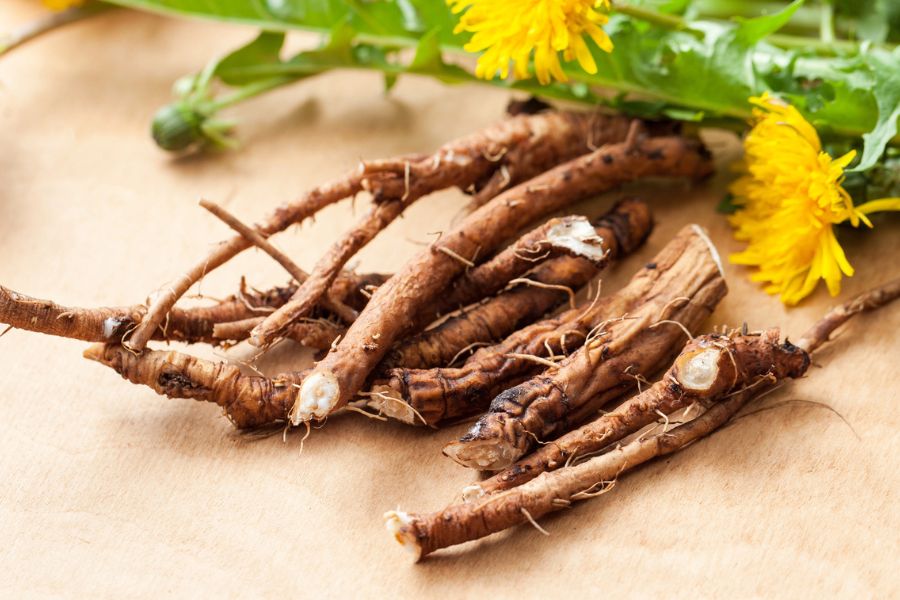Our glass bottles were lined up and ready. We had our wintergreen, fresh vanilla bean, and I told my son, “We need one more ingredient, but we have to go forage it.”
We were on the hunt for a shrub root that gives homemade root beer that classic flavor. Consider the name. We were hunting the sassafras root. It’s the fuzzy mitten-leafed shrub that smells like fruit loops when you rub the leaves between your fingers.
If you eventually plan on exploring the world of natural and wild medicine, the roots are often packed with medicinal qualities. Some of the more bitter roots might not seem like much to write home about in the flavor department, but make great tinctures!
A Quick Reminder
Before we get into the specifics about where and how to find these plants and mushrooms, we want to be clear that before ingesting any wild plant or mushroom, it should be identified with 100% certainty as edible by someone qualified and experienced in mushroom and plant identification, such as a professional mycologist or an expert forager. Misidentification can lead to serious illness or death.
All plants and mushrooms have the potential to cause severe adverse reactions in certain individuals, even death. If you are consuming wild foragables, it is crucial to cook them thoroughly and properly and only eat a small portion to test for personal tolerance. Some people may have allergies or sensitivities to specific mushrooms and plants, even if they are considered safe for others.
The information provided in this article is for general informational and educational purposes only. Foraging involves inherent risks.
Cattail Roots
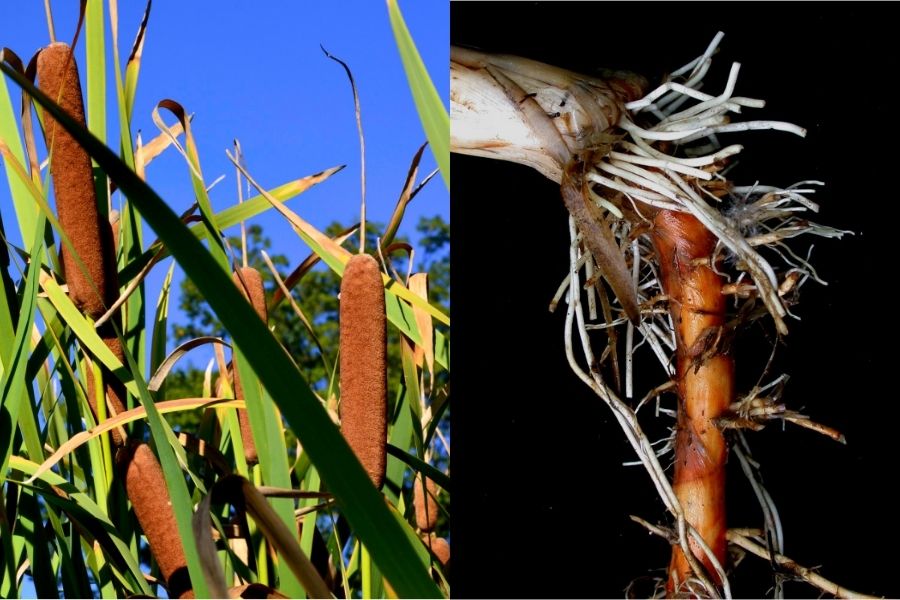
I walk by cattails all year and at all stages of development. If you are a fisherman, then you’ll see the first cattail shoots growing out of the water in spring and the dead fluffing heads in the latter parts of fall.
The starchy root of a cattail is one of the easiest wild tubers to find because you likely already know what a cattail looks like. These tubers grow under water and in the mud so it’s best to have some tall boots if you plan on harvesting them.
Give cattail roots a good rinse once you have pulled them from the water and then peel them with your knife. I think slicing them lengthwise and roasting them is a great way to enjoy this wild root.
Jerusalem Artichoke
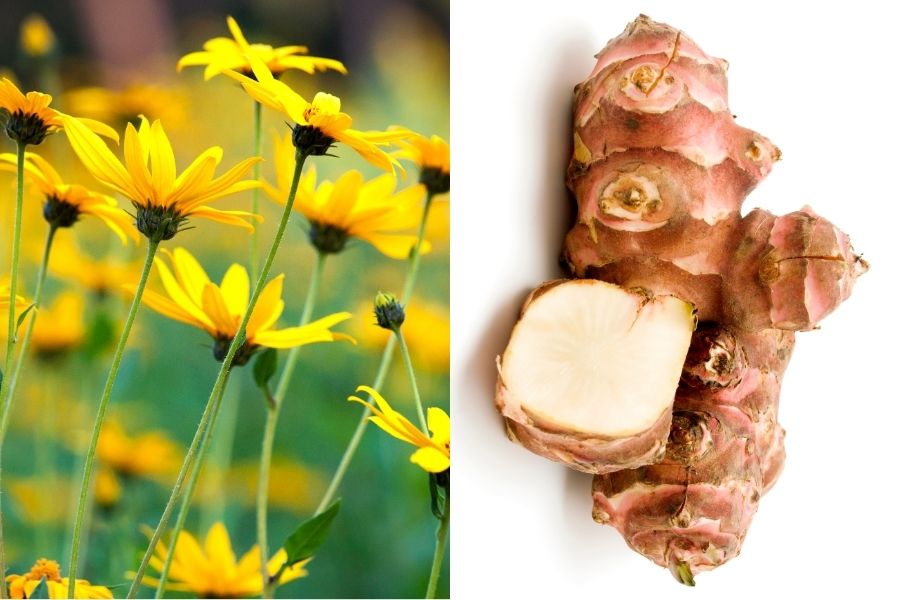
If you want to find a tuber that you just cannot harvest enough of, that’s the highly invasive Jerusalem artichoke or sunchoke. We intentionally plant these tubers on our property for the unrelenting food source but also the beautiful yellow flowers they put off.
At the end of each year, we dig up around 50% of the rootstocks, wash them and store them in a cool, dry place. They taste great peeled and roasted in an oven with some olive oil, salt, and pepper.
If you find a stand of Jerusalem artichoke in the wild, they will have a thick stem that has a rough sandpaper texture. The leaves of the plant are large, dagger-shaped, toothed, and opposite. There are several species of these sunflower-like plants that are similar but do not have edible roots.
The roots of the sunchoke are easy to harvest, and you just snip the stem a few inches from the ground. Using some consistent pressure, you can pull the plant up. If the soil is stubborn, then try using a fork or hori hori.
Yellow Dock
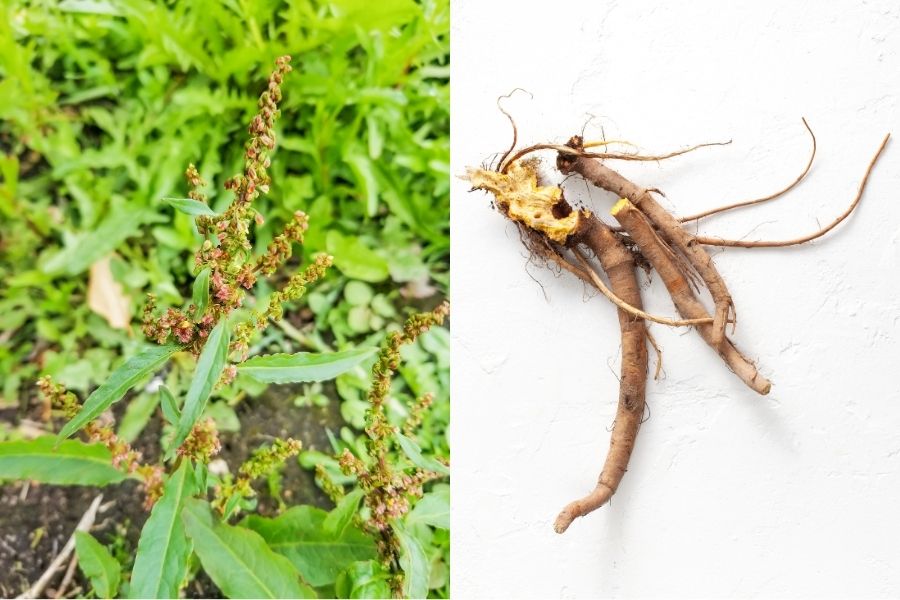
This plant is everywhere. In fact, you can find as many articles about HOW TO REMOVE it as you can about HOW TO FORAGE it. It is a weed that shows up in yards and driveways.
Some people hate it, but for the foragers, yellow or curly dock is a delicious vegetable with tangy leaves that are packed with nutrients.
Being so common, you get a lot of reps with this plant. You can find it in the woods as readily as you can on your walk to the car. Pay attention to the yellow dock at various stages. This will improve your ability to find it in the wild, too.
The root of yellow dock is, well, yellow. You will see it when you peel the root. It is important to note that this root has a bit of a laxative effect so don’t make it the focus of your meal. That could cause other problems for you.
I think the best thing to do with foraged roots that are bitter, like yellow dock, is to mix them into something like a collection of root vegetables and roast them all together. Using things like burdock root, carrots, turnips, salsify, and so on. Whichever ones you enjoy.
Burdock
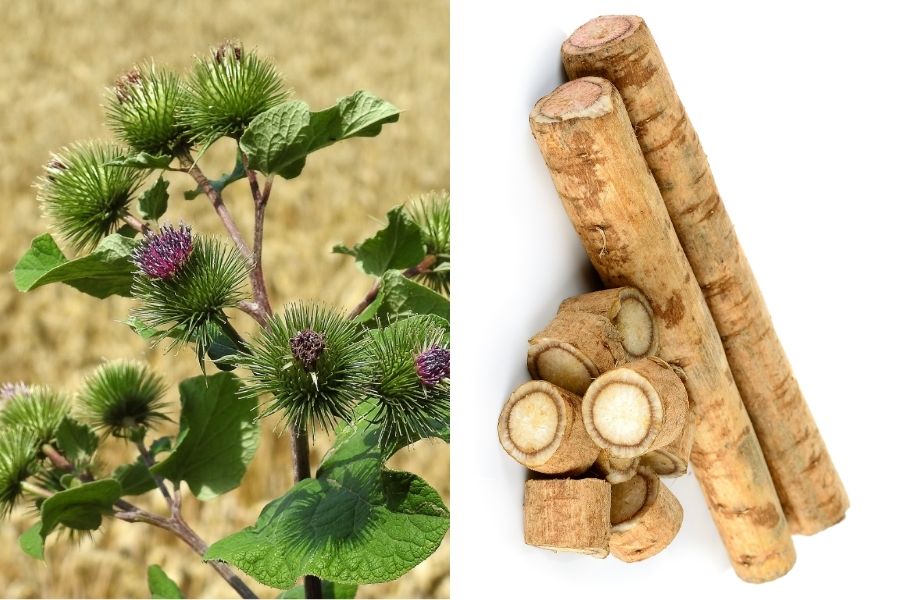
I always laugh at the fact that burdock is a wild edible. I mean, if I asked my 9-year-old to draw me a made-up plant that would clearly be inedible, it would look like mature burdock. The bulb is green and literally covered in spikes.
Even the pretty purple flowers look spiky. However, the leaves of young burdock are tasty. The root of burdock is not only tasty but also medicinal.
Mature burdock roots can get pretty long. The best time to harvest them is in the fall when the leaves of the plant die back.
I peel them and slice them down for boiling or roasting. If you simply want to use burdock root for its medicinal properties slice the root thin and steep it in hot water to create tea.
Salsify
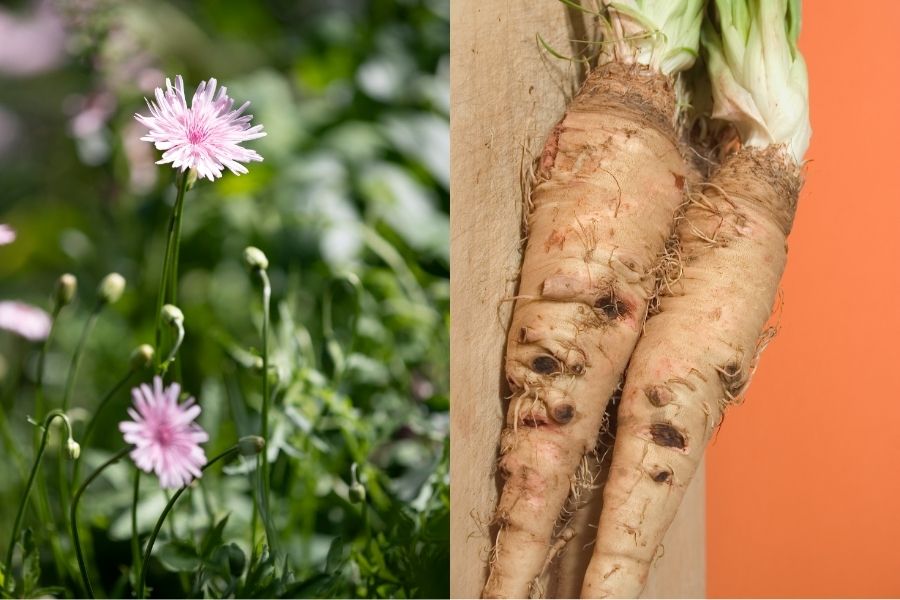
Salsify has entered its culinary arch. You are more likely to find it on the menu of a swanky restaurant than in a post about foraging.
Salsify has a lot in common with the dandelion when it comes to identification. The tufted top of the “wish” seed head of a dandelion also occurs in salsify. The most common plants will put off a purple flower.
The long root is covered in dark skin that needs to be peeled and removed before eating. Once that processing is complete the salsify root can be roasted or sauteed. It has a unique taste and is another food that can be used in your roasted root vegetable mix.
Evening Primrose
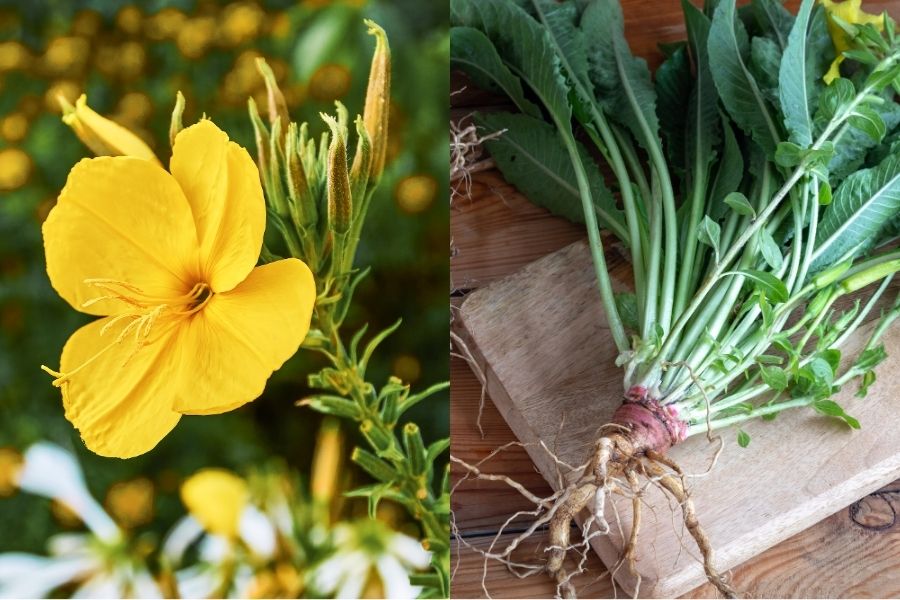
The first time I saw evening primrose root I could only see a small parsnip. The young roots are one of the sweetest of wild roots in the wild. The later you harvest in the season the more bitter it becomes.
As the name implies, the four-petaled white flowers only bloom in the evening after sundown. It is a nocturnal flower, which is pretty rare. This also makes it very easy to identify.
I often look for primrose on my way back from a day of foraging. If you head out a few hours before dusk, then you can look for blooming primrose on your return hike.
Arrowhead
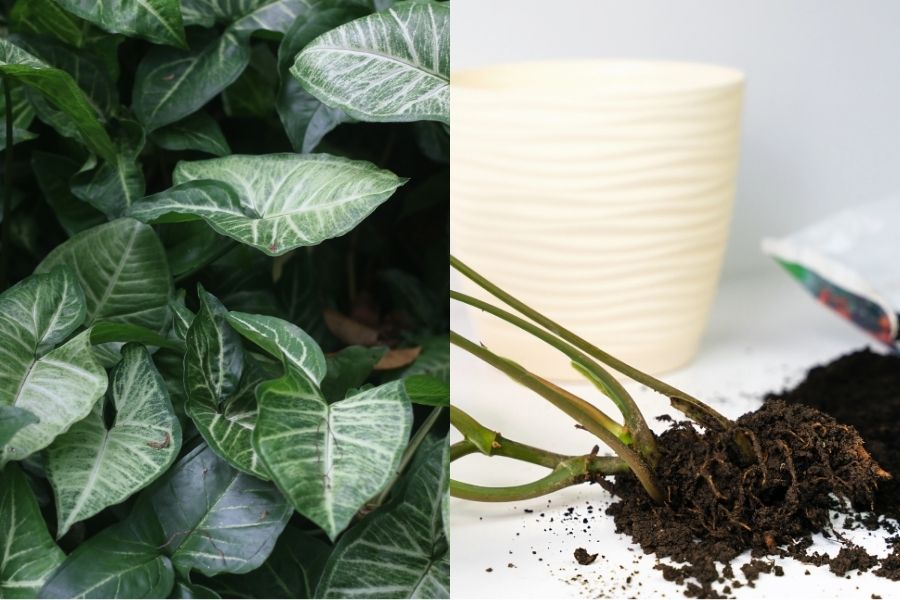
To me, arrowhead, or duck potato, always looked like trouble. The leaves of the plant are shaped like an arrowhead, thus the name, and each point is exaggerated.
Along with the arrowhead leaves some stems form at the center of the plant also put off small white flowers with a yellow center. It is a strange-looking plant, which makes it easy to identify.
The roots can have a blueish hue or be flat white. Arrowhead root has always reminded me of a nutty-tasting potato. The roots grow about the size of an egg and look almost like a small onion with papery outer skin.
Dandelion
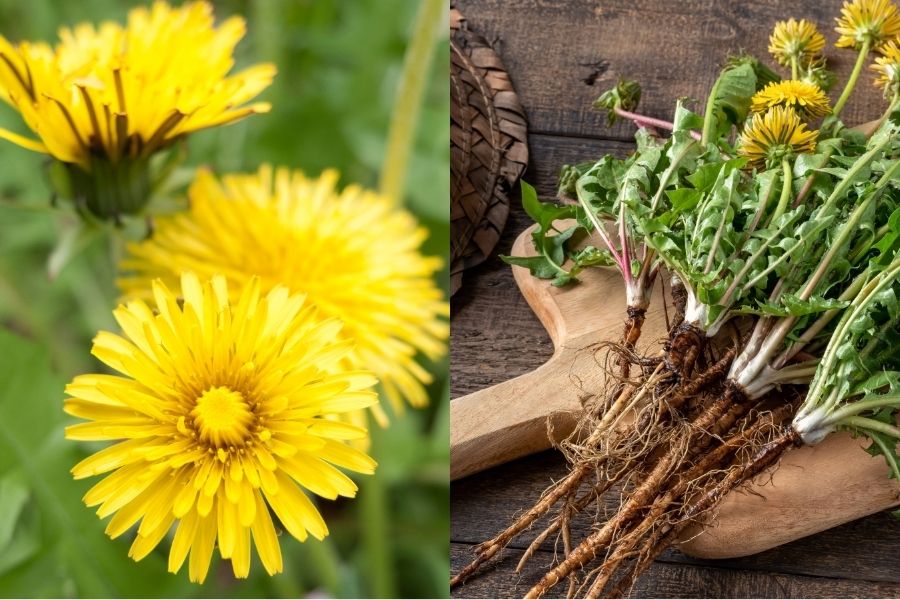
Everybody knows what a dandelion is, right? There is probably a plant in walking distance to us all right now. The leaves, flowers, and roots of this plant are all edible. Forage the entire plant with its yellow head.
Like yellow dock, this is another plant that most people consider a nuisance and there are probably just as many articles on how to remove it as there are on how to forage it.
The root is bitter and is most often roasted, ground up, and used to make a bitter drink similar to coffee but without caffeine.
Wild Carrot
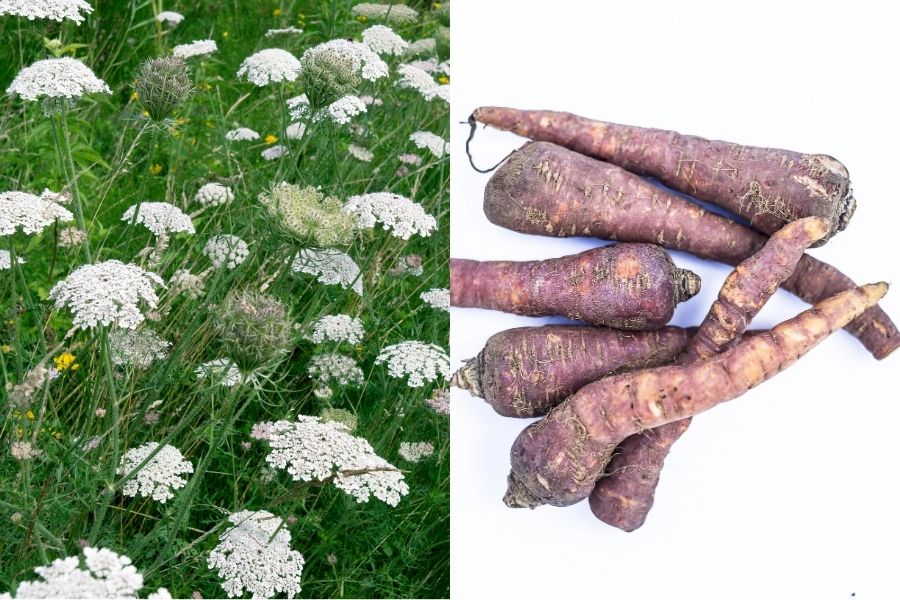
If you are new to foraging, you might be surprised to find out that carrots grow in the wild. Well, it’s a plant called Queen Anne’s lace, which is also known as wild carrot. Wild carrot is not orange and not the size of a typical carrot.
That said, they are pretty easy to find because of their large cluster of flowers. The flower clusters grow on long green furry stems with intricate leaves.
The only trouble with wild carrot is that it has a dangerous look-alike that is highly toxic, known as poison hemlock.
Here are some easy ways to tell the difference between poison hemlock and wild carrot.
- Hemlock’s stem and leaves are smooth. Wild carrot has small hairs on the plant.
- Wild carrot tops out at 5ft tall and poison hemlock can grow up to 10 feet tall.
- Hemlock has purple spots on the stem
- Wild carrot has flowering umbellifers with a dark spot in the center.
Wild Ginger
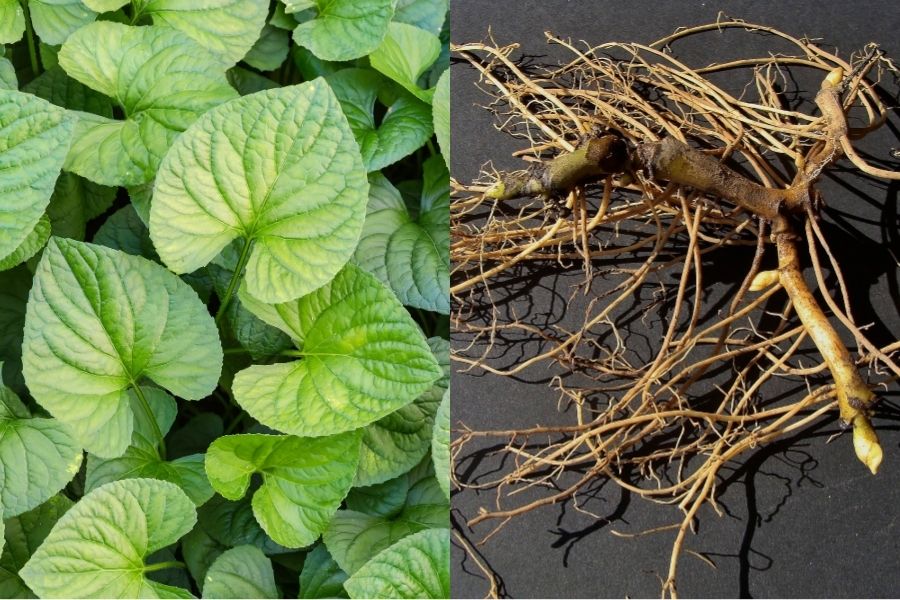
The leaves of the wild American ginger plant look alien to me. This is great news because it means they stand out. I find wild ginger down by the James River in Richmond, Virginia. It really likes to make its home near water sources.
The heart-shaped leaves are thick and sometimes a bit speckled. Ginger will grow in patches, too. So, you won’t find one plant standing on its own.
I spent about 10 years walking by wild ginger on trips down to the river to go fishing. Doing plenty of foraging, I just never even thought to look for ginger in Virginia.
Digging my nail into the root for the first time, I put the scoured plant up to my nose and was hit by that undeniable ginger scent.
BONUS: Chicory
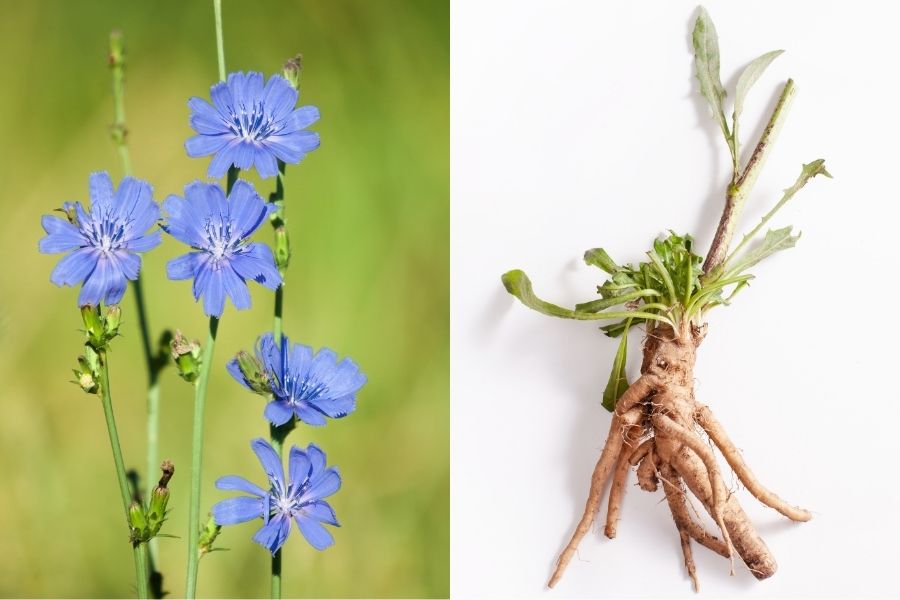
Those beautiful light blue flowers won’t bloom till about late June at the earliest. If you are seeking out chicory before then, you have to become very familiar with its habitat, stalk, and leaves.
Chicory makes its home in disturbed areas. I find it most in the wild fields where other summer wildflowers are blooming. Even before it blooms you can find its long fuzzy stalk that has young flower buds forming along the entire stalk.
Its taproot is very similar in look to something like dandelion or wild carrot. However, this is a world-class coffee substitute when roasted and ground. There is no caffeine but the flavor is right on!
One Final Disclaimer
The information provided in this article is for general informational and educational purposes only. Foraging for wild plants and mushrooms involves inherent risks. Some wild plants and mushrooms are toxic and can be easily mistaken for edible varieties.
Before ingesting anything, it should be identified with 100% certainty as edible by someone qualified and experienced in mushroom and plant identification, such as a professional mycologist or an expert forager. Misidentification can lead to serious illness or death.
All mushrooms and plants have the potential to cause severe adverse reactions in certain individuals, even death. If you are consuming foraged items, it is crucial to cook them thoroughly and properly and only eat a small portion to test for personal tolerance. Some people may have allergies or sensitivities to specific mushrooms and plants, even if they are considered safe for others.
Foraged items should always be fully cooked with proper instructions to ensure they are safe to eat. Many wild mushrooms and plants contain toxins and compounds that can be harmful if ingested.

